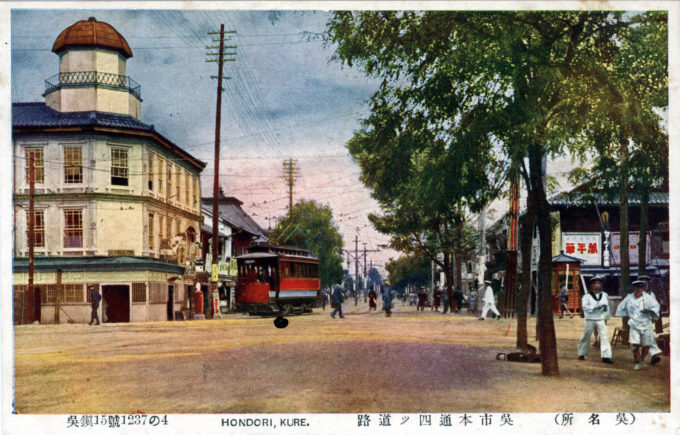See also:
Naval Base Tourism, Souvenir stamps, c. 1935.
“Kure, an important station of the Japanese navy, is romantically situated at the base of the hills of the province of Aki. None but those having permission from the authorities are allowed to inspect the place. One and a half ri distant is the barren island of Etajima, where stands the Imperial Naval College, an admirably conducted institution for the education of cadets.”
– A Handbook for Travellers in Japan, Basil Hall Chamberlain & W.B. Mason, 1891

Panoramic view of Kure City and harbor, c. 1950. Showing the relative distances from Kure to Miyajima and Hiroshima.
“Kure is located 20 kilometres (10 mi) south-west of Hiroshima city and faces the Seto Inland Sea. Surrounded by steep hillsides to the north, the two major commercial and industrial centers of the city are bisected by Mount Yasumi 497 m (1,631 ft).
“The location of Kure within the sheltered Inland Sea of Japan was recognized of strategic importance in controlling the sea lanes around western Japan by the Meiji government and early Imperial Japanese Navy. With the formation of the navy in 1886, Japan was divided into five naval districts for recruiting and supply. During the administrative re-organization of the Japanese Navy in 1889, Kure was designated as the ‘Second Naval District’, and its harbor was dredged, a breakwater constructed and docking facilities for warships were established.
“The following year, in 1890, work began on the Kure Naval Arsenal, which would eventually expand to become one of the largest shipyards in Japan for the construction of large capital ships and the rapid growth of both steel production and shipbuilding in the city. Kure City itself was formally incorporated on October 1, 1902. From 1889 until the end of World War II, the city served as the headquarters of the Kure Naval District.
“Kure dockyards recorded a number of significant engineering firsts including; in 1905 the launching of the first major domestically built capital ship, the cruiser Tsukuba, and, in 1940, the launching of the largest battleship ever built, the Yamato. The Imperial Japanese Naval Academy and Naval Staff College were relocated ca. 1890 from Tokyo to nearby Etajima. In 1920, the Japanese navy established its main submarine base and submarine warfare training school in Kure. An air wing was established in 1932, and a telecommunications center in 1937.
“The bombing of Kure and surrounding areas by United States and British naval aircraft in late July 1945 led to the sinking of most of the surviving large warships of the Imperial Japanese Navy (IJN). The attacks resulted in the sinking of aircraft carrier Amagi, and the cruiser Ōyodo, which at this time was acting as the Combined Fleet’s flagship. The battleships Hyūga, Ise, and Haruna, the heavy cruisers Tone and Aoba, and the outdated armored training cruisers Iwate and Izumo were all heavily damaged and settled in shallow water.”
– Wikipedia



